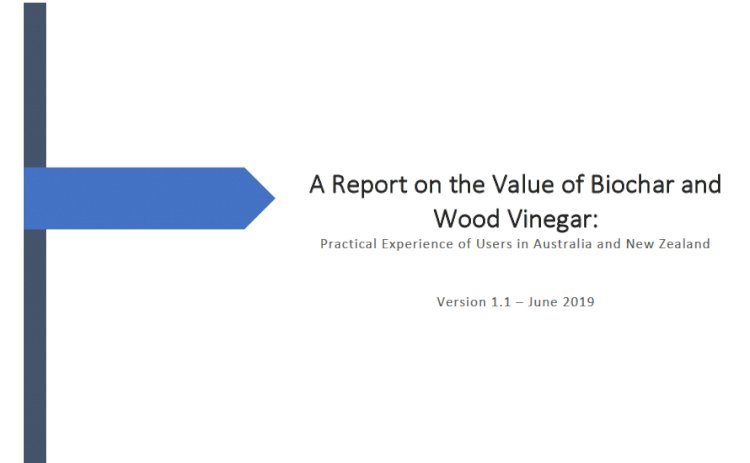A Report on the Value of Biochar and Wood Vinegar: Practical Experiences of Users in Australia and New-Zealand
Biochar and wood vinegar values are outlined in this report based on practical experiences from users located in Australia and New-Zealand. Case studies on economics and advantages are included.

Purpose
This paper discusses practical uses of biochar and the end outcomes based on the early adopters in the field. This report is not a scientific paper and instead relays practical information regarding in the field end use examples, application methods, short and some long term outcomes and importantly financial information. It is meant for people that want to hear about the uses of biochar in the field, understand different application scenarios and what the outcomes were – we are hoping that these early adopter examples will inspire others to follow. This white paper is not the end of the story, and we hope to add many more examples in later revisions – maybe yours will be one.
We'd be keen to hear your feedback, and if you have your own stories/ photos/ data of the use of biochar in field, green roof, agriculture, horticulture, cattle feed, the backyard vegie garden, Orchids or whichever the end use might be, we'd want to add them to this report for the next release. Please let us know
For feedback, input, data, etc. contact Don Coyne at publicofficer@anzbi.org
Summary
Biochar and wood vinegar are emerging technologies with numerous applications in agriculture and environmental remediation1. Advocates and early adopters of these products are well versed in their positive attributes. Biochar, for example, has been shown generally to increase crop yields in tropical latitudes2 i, remediate soil3, reduce soil greenhouse gas emissions4,5, and sequester carbon6 amongst many other observed benefits1,7.
Yet it is arguably the case that not enough focus has been given in financial feasibility studies to the benefits observed by users of biochar beyond its use as a soil amendment8. Existing studies in highincome countries tend to focus on soil amendments in low value cereal crops, and with the exception of Joseph, et al.9, they overlook biochar’s use as an animal feed, for soil remediation and for water use efficiency.
This report begins to address this knowledge gap by providing an account of how biochar and wood vinegar users are accruing benefits or disbenefits in their farming operations. In March and April of 2019, the Australian New Zealand Biochar Initiative (ANZBI) surveyed sixteen current users of biochar and six users of Wood Vinegar.
The survey found that:
- The use of biochar as animal feed is an important emerging market in Australia. Those who feed biochar to cattle do so on a daily basis for the purpose of improved cattle health, improved cattle weight gain, methane emissions reduction and reduced feed cost.
- Biochar is being used as a soil amendment to improve the crop yields and the produce quality of higher value crops (fruits, vegetables, nuts, horticulture), but the business case remains challenging for broadacre cereal crops. These users were found frequently to produce their own biochar and to apply it on a monthly or annual basis.
- Adding small amounts of biochar and minerals to chemical fertilisers (as has now been commercialised in China) has the potential to increase yield, profitability and quality of vegetables and grains.
- Wood vinegar is being used to increase rates of seed germination, reduce fungal diseases and to improve both plant health and crop quality. Users of this product were frequently fruit and nut farmers.
Furthermore, the report includes in-depth case studies including biochar’s use in a golf course, for use in an avocado orchard, for use as an animal feed and for use in a potato farming operation. These in-depth case studies exhibit circumstances under which biochar not only breaks even for the user, but is lucrative.
A review of the biochar literature examines emerging products and innovations. It highlights the importance of practices such as banded application for improved user value and the high performance of biochar fertilisers. It further remarks on the discrepancy between the literature and the commercial reality.
Finally, we make the following recommendations:
- That ANZBI develop standards for biochar’s use for soil application and as an animal feed. Standards are crucial, as they enable biochar manufacturers to follow common transparent guidelines and quality assurance to gain customer and regulatory trust. ANZBI is committed to the establishment of these standards. The first standard, biochar for soils, is currently under development.
- Work with existing users of biochar and wood vinegar to identify practices that maximise the benefits from using biochar and wood vinegar.
- Assist innovators/early adopters in farming and waste management sector to trial fit for purpose biochars.
- More attention must be given by users, producers, government and private sector agronomists, agricultural scientists and academics to alternative uses of biochar beyond focusing on soil amendments, particularly as an animal feed supplement, for water holding capacity (for reduced irrigation requirements), partial replacement of chemical fertilisers and environmental remediation.
- More research and well-resourced field trials are required to understand and quantify the benefits to farmers accrued via wood vinegar application.
- More large scale field trials are required to evaluate the applications of biochar based chemical fertilisers given their demonstrated capacity to outperform commercially available slow release fertilisers.
- Development and large scale field trials are required of new biochar based products (e.g. extracts for fertigation or foliar sprays) that can be applied at low application rates with existing application equipment.
- Funding is required for large scale demonstration projects where biochar is a component of a larger effort to utilise a waste resource ( e.g. wood residues from clear fell operations and timber processing) to reduce nutrient runoff and increase soil health. The projects need to be wellresourced so that they do not require any significant input from farmers over and above their normal day to day activities.
i Though on average, not in temperate latitudes.
















